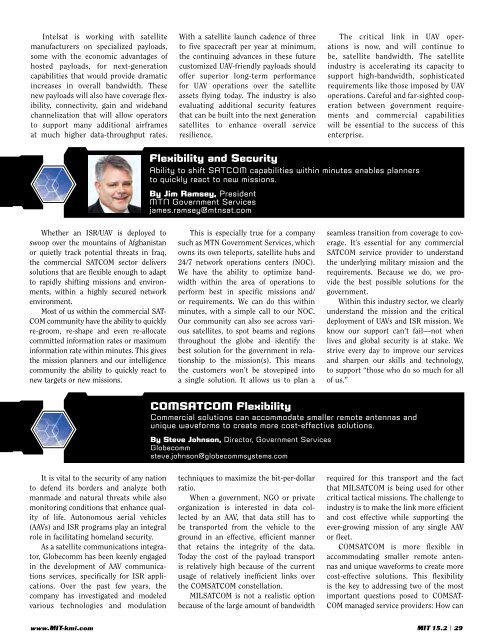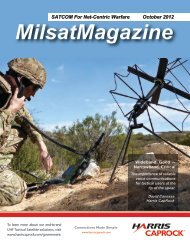Satcom for ISR - Harris CapRock
Satcom for ISR - Harris CapRock
Satcom for ISR - Harris CapRock
- No tags were found...
You also want an ePaper? Increase the reach of your titles
YUMPU automatically turns print PDFs into web optimized ePapers that Google loves.
Intelsat is working with satellite<br />
manufacturers on specialized payloads,<br />
some with the economic advantages of<br />
hosted payloads, <strong>for</strong> next-generation<br />
capabilities that would provide dramatic<br />
increases in overall bandwidth. These<br />
new payloads will also have coverage flexibility,<br />
connectivity, gain and wideband<br />
channelization that will allow operators<br />
to support many additional airframes<br />
at much higher data-throughput rates.<br />
With a satellite launch cadence of three<br />
to five spacecraft per year at minimum,<br />
the continuing advances in these future<br />
customized UAV-friendly payloads should<br />
offer superior long-term per<strong>for</strong>mance<br />
<strong>for</strong> UAV operations over the satellite<br />
assets flying today. The industry is also<br />
evaluating additional security features<br />
that can be built into the next generation<br />
satellites to enhance overall service<br />
resilience.<br />
The critical link in UAV operations<br />
is now, and will continue to<br />
be, satellite bandwidth. The satellite<br />
industry is accelerating its capacity to<br />
support high-bandwidth, sophisticated<br />
requirements like those imposed by UAV<br />
operations. Careful and far-sighted cooperation<br />
between government requirements<br />
and commercial capabilities<br />
will be essential to the success of this<br />
enterprise.<br />
Flexibility and Security<br />
Ability to shift SATCOM capabilities within minutes enables planners<br />
to quickly react to new missions.<br />
By Jim Ramsey, President<br />
MTN Government Services<br />
james.ramsey@mtnsat.com<br />
Whether an <strong>ISR</strong>/UAV is deployed to<br />
swoop over the mountains of Afghanistan<br />
or quietly track potential threats in Iraq,<br />
the commercial SATCOM sector delivers<br />
solutions that are flexible enough to adapt<br />
to rapidly shifting missions and environments,<br />
within a highly secured network<br />
environment.<br />
Most of us within the commercial SAT-<br />
COM community have the ability to quickly<br />
re-groom, re-shape and even re-allocate<br />
committed in<strong>for</strong>mation rates or maximum<br />
in<strong>for</strong>mation rate within minutes. This gives<br />
the mission planners and our intelligence<br />
community the ability to quickly react to<br />
new targets or new missions.<br />
This is especially true <strong>for</strong> a company<br />
such as MTN Government Services, which<br />
owns its own teleports, satellite hubs and<br />
24/7 network operations centers (NOC).<br />
We have the ability to optimize bandwidth<br />
within the area of operations to<br />
per<strong>for</strong>m best in specific missions and/<br />
or requirements. We can do this within<br />
minutes, with a simple call to our NOC.<br />
Our community can also see across various<br />
satellites, to spot beams and regions<br />
throughout the globe and identify the<br />
best solution <strong>for</strong> the government in relationship<br />
to the mission(s). This means<br />
the customers won’t be stovepiped into<br />
a single solution. It allows us to plan a<br />
seamless transition from coverage to coverage.<br />
It’s essential <strong>for</strong> any commercial<br />
SATCOM service provider to understand<br />
the underlying military mission and the<br />
requirements. Because we do, we provide<br />
the best possible solutions <strong>for</strong> the<br />
government.<br />
Within this industry sector, we clearly<br />
understand the mission and the critical<br />
deployment of UAVs and <strong>ISR</strong> mission. We<br />
know our support can’t fail—not when<br />
lives and global security is at stake. We<br />
strive every day to improve our services<br />
and sharpen our skills and technology,<br />
to support “those who do so much <strong>for</strong> all<br />
of us.”<br />
COMSATCOM Flexibility<br />
Commercial solutions can accommodate smaller remote antennas and<br />
unique wave<strong>for</strong>ms to create more cost-effective solutions.<br />
By Steve Johnson, Director, Government Services<br />
Globecomm<br />
steve.johnson@globecommsystems.com<br />
It is vital to the security of any nation<br />
to defend its borders and analyze both<br />
manmade and natural threats while also<br />
monitoring conditions that enhance quality<br />
of life. Autonomous aerial vehicles<br />
(AAVs) and <strong>ISR</strong> programs play an integral<br />
role in facilitating homeland security.<br />
As a satellite communications integrator,<br />
Globecomm has been keenly engaged<br />
in the development of AAV communications<br />
services, specifically <strong>for</strong> <strong>ISR</strong> applications.<br />
Over the past few years, the<br />
company has investigated and modeled<br />
various technologies and modulation<br />
techniques to maximize the bit-per-dollar<br />
ratio.<br />
When a government, NGO or private<br />
organization is interested in data collected<br />
by an AAV, that data still has to<br />
be transported from the vehicle to the<br />
ground in an effective, efficient manner<br />
that retains the integrity of the data.<br />
Today the cost of the payload transport<br />
is relatively high because of the current<br />
usage of relatively inefficient links over<br />
the COMSATCOM constellation.<br />
MILSATCOM is not a realistic option<br />
because of the large amount of bandwidth<br />
required <strong>for</strong> this transport and the fact<br />
that MILSATCOM is being used <strong>for</strong> other<br />
critical tactical missions. The challenge to<br />
industry is to make the link more efficient<br />
and cost effective while supporting the<br />
ever-growing mission of any single AAV<br />
or fleet.<br />
COMSATCOM is more flexible in<br />
accommodating smaller remote antennas<br />
and unique wave<strong>for</strong>ms to create more<br />
cost-effective solutions. This flexibility<br />
is the key to addressing two of the most<br />
important questions posed to COMSAT-<br />
COM managed service providers: How can<br />
www.MIT-kmi.com MIT 15.2 | 29




